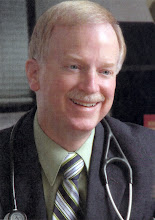
"God whispers to us in our pleasures, speaks in our conscience, but shouts in our pains: it is His megaphone to rouse a deaf world." C.S. Lewis, The Problem of Pain
We just returned from UVA where I underwent an ultrasound-guided needle biopsy to assess whether or not the three small areas of increased metabolic activity in the neck and right arm pit that lit up on a recent PET/CT scan actually represent recurrent melanoma. The experience served as a helpful reminder to me that pain has a purpose.
None of these lesions was palpable on exam and the ones in the neck were too tiny to even attempt to biopsy. The interventional radiologist therefore directed his attention to the right arm pit. The aim was to visualize the exact location of the suspicious nodule with high-frequency sound waves, impale it with a large bore hypodermic needle passed through the skin into the center of the lesion, and aspirate tiny bits of tissue into the shaft of the needle and attached syringe.
He began by pressing the ultrasound transducer firmly into my right axilla and in short order identified an abnormal lymph node deep in the recess. After prepping the area and providing a local anesthetic, he made a tiny incision in the skin and guided the needle toward its mark. Because of the relatively small size of the target lesion, the difficulty visualizing the needle on the ultrasound image, and the typical reluctance of lymph nodes to hold still while being attacked by a sharp instrument, repeated thrusts with the needle failed to produce any tissue. These maneuvers did produce considerable pain, however.
The radiologist offered additional local anesthetic to the deep space in my arm pit, but I declined. “It looks like we have a tough guy here,” he quipped to the technician. “Not really,” I replied, “But by the nature and location of the pain, I can tell when your needle is pressing against the involved node.” So I turned from passive subject to active participant in the procedure.
As the physician made repeated attempts to skewer the elusive mass from different angles, my grimaces and muffled yelps served as confirmation that his stiletto-like probe was zeroing in on the intended target. This game of thrust and parry continued for a full hour. Then with an “Arghhhh… Ohhhh, yeah… That’s it!” the hard little mass could resist no longer: a delft stab through its midsection finally yielded adequate tissue for pathologic examination.* The cheers arising from the gallery were deafening :-)
I’m really not a glutton for punishment, and now that the procedure is over, I’d say the level of pain was really quite tolerable. It certainly cannot be compared to the still-vivid memories of excruciating torment that attended a complicated liver biopsy eighteen months ago. Nor am I averse to taking pain meds when needed – More than once has Dilaudid brought me from the brink of unconsciousness triggered by unbearable pain to a state of complete relief and relaxation.
But this most recent encounter with pain has underscored the positive role that noxious stimuli and their physiologic response play in our lives. Indeed, pain produces a reaction in us that is both protective and life-affirming. Repeated admonitions to a toddler to avoid the hot stove or the flame of a candle are seldom heeded until that first misadventure. It took the painful experience of a dislocated toe to teach me not to descend our slick hardwood stairway in stocking feet!
This beneficial role of pain is dramatically and tragically revealed in those medical conditions in which the normal pain mechanism is impaired, such as the peripheral neuropathy that often accompanies advanced diabetes. I recall one diabetic patient of mine who suffered third degree burns to her feet by exposing them to excess heat without any awareness of pain or injury. She ultimately lost both feet.
Of course there are those conditions which produce chronic debilitating pain that seemingly has no positive protective purpose (e.g., fibromyalgia, reflex sympathetic dystrophy, primary neuralgias, etc.) And many suffer unbearable emotional pain from the loss of a loved one, repeated rejection, or other adversity. To be honest, it is in these circumstances that pain seems to mock us rather than preserve us.
As one who has experienced the destructive side of pain, the intractable bone-wracking pain that accompanies the rampages of disseminated cancer, I can sympathize with those for whom this type of suffering is a daily experience. My entire professional career (and that of my colleagues) was devoted to preventing and/or alleviating this kind of misery.
Nevertheless, even here I have found that pain has a purpose. I can say with honesty that, as strange as it sounds, I never felt more alive than during those long nights when I was immobilized with pain from head to toe caused by the rapidly advancing malignancy. In the midst of what was clearly “the valley of the shadow of death”, my head and heart were compelled to confront whether life consisted solely of this biologic existence or indeed encompassed eternity.
As C.S. Lewis suggests, it was in the midst of this kind of pain, that God used a megaphone to reassure me of His promise: “I came that they may have life and have it abundantly.” (John 10:10b) He came. He lived as one of us. He knew rejection. He suffered a measure of pain I will never know. And He did it all that I might know what it is to truly live. My personal experience with pain stripped me of any pretense of self-sufficiency. It taught me to celebrate His presence and His promise, secured by trusting Him fully. It continues to be a remarkable journey.
Dr. (Pincushion) Dan
*As expected, the microscopic analysis of the needle biopsy specimen demonstrated the typical pigment-laden, distorted cellular architecture of malignant melanoma. We return to UVA next week to discuss treatment options with Dr Grosh.

